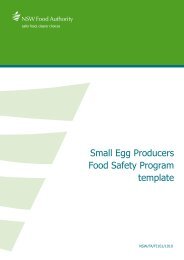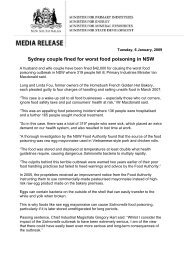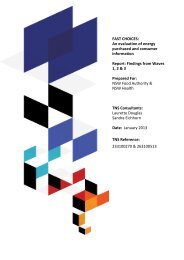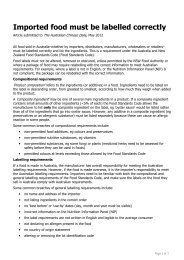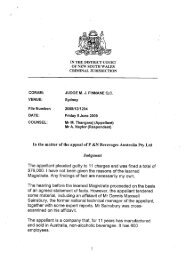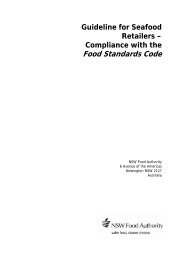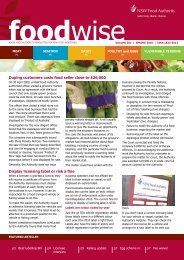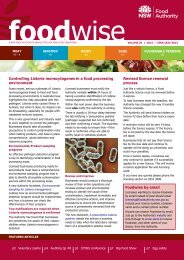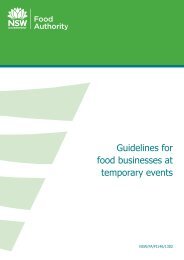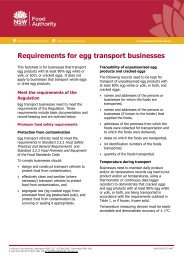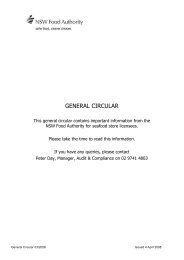Reasons for decision, CIM Hart, 11 February 2009, QSR Pty Ltd
Reasons for decision, CIM Hart, 11 February 2009, QSR Pty Ltd
Reasons for decision, CIM Hart, 11 February 2009, QSR Pty Ltd
- No tags were found...
Create successful ePaper yourself
Turn your PDF publications into a flip-book with our unique Google optimized e-Paper software.
LOCAL COURT OF NEW SOUTH WALES@owning Centre)JURISDICTION: CriminalPARTIES:In<strong>for</strong>mant:Defendant:NSW FOOD AUTHORITY(Officer Angela Wong)<strong>QSR</strong> PTY LTDcase Nos:2034371310812,2034372U0812,2034373010812,2034375610812,203 437 7 21 08 I 2, 203 437 83 I 08 12, 203 416201 08 12, 203 41 6ll I 08 12,203 4167 3 I 08 12, 203417 00 I 08 12, 203417 l8l 0812Hearing Date: 16 December 2008Date of Decision: <strong>11</strong> <strong>February</strong> <strong>2009</strong>Legislation: Food Act 2003, 521(1)Magistrate:GJT<strong>Hart</strong>Representation: Solicitor <strong>for</strong> the ProsecutorMr D MuddleNSW Food Authority Legal ServicesSolicitor <strong>for</strong> the DefendantMrNicholMahony Dominic LawYersCounsel <strong>for</strong> the DefendantMr Djemal
REASONS FOR DECISIONThe Defendant pleads guilty to <strong>11</strong> breaches of 521(1) of the Food Act. When thematter came on <strong>for</strong> sentencing hearing on 16 December 2008, the Court was in<strong>for</strong>medthat the Prosecutor had originally brought a total of 22 separate charges against theDefendant company. The company had made representations concerning the issue ofduplication of charges, and following negotiations between the parties, some of thecharges were withdrawn and others were amended in terms of the particulars of thealleged charges. Following that process, there remained <strong>11</strong> separate charges, and theDefendant pleads guilty to each of them.The Prosecutor's tender bundle, which became Exhibit 1 in the proceedings, included aStatement of Facts setting out relevant factual matters as agreed between the parties'The Statement of Facts provides the Court with the following in<strong>for</strong>mation:-uA BøckgroundSFt At all material times, the offending compqny, <strong>QSR</strong> <strong>Pty</strong> <strong>Ltd</strong>, wqs a registeredAustralian corporation. The company operates and manages a number of'KFC' Restaurants throughout metropolitan Sydney and NSW. It operated andmanaged thefood businesses described as the 'KFC RestaLtrant' at 642-646 TheKingsway, Miranda, and the 'KFC Restaurant' at 309b Forest Road, Hurstville,respectively.SF2 fhà food premises at Mirandq was inspected by Food Authority fficers on 28May, 18 June, 20 June, 2l June 2007 and 2l <strong>February</strong> 2008. Thefoodpremisesat Hurstville was inspected on 25 <strong>February</strong> 2008. As a result of thoseinspections, the eleven charges listed in the table above were laid.B Offences 1-5 (Bet',ween 28 May 2007 and 20 June 2007 øt Mirøndø)SFI A.t about <strong>11</strong>.44 em on 28 May 2007, Food Safety Officer, Angela Wong, inresponse to a telephoned complaint to the NSW Food Authority from anunldentffied member of the public, entered the 'KFC'food business Restaurantsituated at 642-656 Kingsway, Miranda.SF2 Officer Wong identified herself and asked to speak with the person in charge, orstore mana{er, of the þod business. A short time later, a female appeared.Officer Wong siowed the female her authority and indicated that she hadattended to pedorm an inspection of the premises.SF3 On inspection, Officer Wong observed thefollowing defects inside the premises:(Offince 1):o A cigarette butt and waste material on the floor underneath the dried goodsstorage. (PhotograPh 1,2)
o Dirt qnd other visible matter on the floor of the chemical storage area(Photogrøphs 3).o The floor underneath the benches and cooking equipment had deposits ofgreqse, food waste and other visible matter' (Photographs 7' 8, 9).o The fan guards inside the cool room had dirt and dust on them and theexternal cool room door was unclean.(Offence 2):o The undersides of the chicken deep fryers were covered with burnt solidffiedgrease. (Photographs 12, 13' 14, l5).(Offence 3):o The floor, wall and piping underneath the wash up sink were dirty andmouldy. (PhotograPhs 4, 5,6).(OÍfence 4):o The presence of rust at the base of the rear door frame. (Photographs I,16).(Offence 5):o The presence of rust on the storage stands in the dried goods storage areaand inside the cool room. (Photograph <strong>11</strong>).Also noted by Officer Wongwere:-o A míssing tile on thefloor inside thefreezer'o Damaged tiles on the wall in the wash up area. (Photograph 17).SF4 On request, the female who permitted entry to Officer Wong identified herself asSarah Fitzg"roid, the Assistant Restaurant Manager. Officer Wong confirmedthe name and address of thefood business, and indicated that she would proceedto take photographs of the defects observed and identified. Fitzgerald contactedthe area *oiog"r, Daniel CRAWFORD and Office Wong spoke with him aboutthe inspection. Officer Wong described to Craw<strong>for</strong>d the defects, indicated shewould be taking photographs and would be issuing an improvement notice.Officer Wong further indicated that she was entitled to inspect the premises ingàneral as part of her investigatíon. Officer Wong took photographs of theâ"¡nrtt and completed her inspection, leaving the premises at 12.22 pm, afterretrieving and delivering to Fitzgerald a standard copy of her powers as anauthorised fficer.SFj On 29 May 2007, an Improvement Notice was prepared and faxed to theoffender. A copy was also sent to the offender's registered ffice by registeredmail, and a fuither copy was addressed to the store manager and sent to thefood business premisòs at Mirandø. Officer Wong extended the period þrcompliance with the notice (normally 24 hours) to I June 2007. (Annexure A)SF6 At about <strong>11</strong>.47 am, on 18 June 2007, Food S"f"ty Officers llong and JimTsirigotes, entered the KFC Restaurant at Miranda to inspect the defendant'sfood business in order to establish that the defects, as set out in the Improvement-Notice of 29 May 2007, had been rectified and the Notice complied with.SF7 The O/ficers iãentified themselves and met again with Sarah Fitzgerald øndMichael Anderson, who identified himself as the Facility Manager of thedefendant company.SFd During the inipec:tion the fficers observed that the defects listed and describedon the Improvàment Notice had not beenfully rectified. Photographs were taken
SF14 Fitzgerald indicated that 'Ik did have a genuine attempt at fixing up everythingyou-had on the list. We thought we had, obviously we didn't.' In respect to the'storage rack (Offince 5) Anilerson indicated that he 'misread or misunderstoodthe Ñotice.' Aiderson maintained he had replaced shelving 'other than that',which was acknowledged by Officer Wong' (196)'SFI5 The Officers indicateã b Fitzgerald that the defects needed to be addressed assoon qs possible. Fitzgerald indicated that the defects would be addressed byWednesclay, and the O¡¡r"rt agreed to return to the premises on Wednesdayafter the premises were open<strong>for</strong> business'SFl6 Å, orroigrd, at about lb.lS am on 20 June 2007, Food Safety Officers Wongand Tsirigoies again attended the KFC at Miranda in order to reinspect thepremises/or rectification of the outstanding defects on the Improvement Noticeissued on 29 May 2007. ¿t the premises the fficers met with DanielCRAWFORD, who identified himself as the Area Manager of <strong>QSR</strong> <strong>Pty</strong> <strong>Ltd</strong> alongwith Michael Anderson, the Facitity Manager. The fficers again þund that anumber of the defects listed and described on the original Improvement Noticewere still not rectified. These were as follows:(Ofþnce 1):o The right hand side wall underneath the wash up sink remained greasy.o The underside of the drainage tray of the wash up sink remained unclean.o Food waste, grease and other visible matter remained on the floor underneaththe benches and cooking equipment. (Photographs IB, 28, 38, 4B).(Ofþnce 2):o The undersides of the chicken deep fryers retained burnt solidified fat on them,as reflected in the earlier inspections. (Photograph 58, 68)'(Offence 3):o The exposed and internal sudaces of the chip station were greqsy and dirt wasseen on the power units. (Photograph 9B).SFIT In addition to the defects outstanding on the Improvement Notice, fficersobserved that:o The wall behind the mixer was unclean'o The wheels on the standing upright holding oven were greqsy.o Recycled matter, including soft drink can and other visible matter were seen onthefloor underneath the drive thru serving area. (Photograph 7B).o Recycled matter and other visible matter were seen on the floor underneath thefiling cabinet. (PhotograPh 8B).o Food waste, dirt and other visible matter were seen in the storage area of singleuse packaging items such as chip holders. (Photograph 108, l lB).o The serving trays storage areawas greasy. (Photograph 128).. The base of the bottle drinl
to the other observøtions, would be considered by the Authority <strong>for</strong> furtheraction, including the issue of a Prohibition Order'SF20 Following the inspection, Officers Wong and Tsirigotes returned to the NSWFood Authority Office, where, after consultation with the Director ofEn<strong>for</strong>cement, a Prohibition Order wqs prepared and authorised <strong>for</strong> service onthe company. (Annexure B).SF21 On 2l June 2007, the þtlowingday, Officers Angela Wong and Peter Srzich,entered the registered ffice of the company situated at Level 1, 183-193 SpringStreet, Bondi junction. They were met by Adrian Holness. Officer Angela Wongserved the Prohibition Order on Adrian Holness. Officer Peter Srzich explainedthe details stated in the Prohibition Order. After receiving legal advice, Holnessconsented to and participated in a recorded interview on behølf of the Company,eSR pty <strong>Ltd</strong>, regardirg no, complictnce with the Improvement Notice issued <strong>for</strong>the inspection at the Miranda store on 28 May 2007'SF22 Hotness identified himself as the person responsible <strong>for</strong> the operation andadministratioi of the company and was able to speak on its behalf' Holnessconfirmed he was o*ori of the previous inspections and the results. Heindicated that, in respect to taining, personal files in relation to each staffmember were retaiied at the respective store. As to the issue of theimprovement notice and prohibition orders, Holness stated that there had been a'breakdown in procedure from an internal point of view' as it was thecompany's potiiy to 'provide the upmost co-operation fuffilling any of thoseordàrs; ëgq. Holness stqted that the company would be taking action to'make sure in the future it doesn't happen' and that the individuals involvedwould be disciplined. (301).SF23 Fottowing the conclusion of the interview, at about 1.46 pm, Officers Wong andSrzich entered the KFC Restaurant situated qt 642-656 Kingsway, Mirandq.The fficers met upon entry Adrian Holness, Daniel Craw<strong>for</strong>d and MichaelAnderson, in the foid prepa.ration area. Officer Angela Wong serued-a copy ofthe prohibition -Ordei on the premises by handing it to Adrian Holness- Aninspection was carried out of the premises. Officer Wong observed that:. The wheels underneath the chip cookers were greasy. (Photograph LC, 2C).o The undersides and wheels underneath the chicken deep fryerswere greasy.(Photographs 3C,4C).o The storage racks inside the cold drinkfridge were unclean. (Photograph 5C).o Thefloor inside the coolroom was unclean'SF24 Discussion took place between the Officers and Adrian Holness regarding theneed and requiråments under the Food Act þr cleanliness of the premises andequipment. Mr Holness was in<strong>for</strong>med of his right to request a re-inspection <strong>for</strong>the purposes of a clearance certificate.SF25 On 25 June 2-007, Officer í4long received afaxfrom <strong>QSR</strong> <strong>Pty</strong> <strong>Ltd</strong> requesting aninspection <strong>for</strong> the purposes of a Certfficate of -Clearance.That morning,Officers Aigela llrong-and Peter Srzich entered the KFC situated at 642-656Kingsway, Miranda to re-inspect the premises. Photographs were taken of thecondition inside the food preparation area and equipment- Officer Srzichnoticed that the undeiside i¡ tnn chip station still retained grease, and requiredfurther cleaning. These oiservations were brought to the attention of Holness
qnd the fficers teft the premises in order to allow the company to continuecleaning.SF26 At about 2.00 pm that afternoon, the Officers returned to the premises and againinspected the food preparation area and general areas. officer wong took anumber of photogiaphs, and the Officers returned to the Food Authorityheadquariers, wháre- it was decided by the Authority that a Certificate ofCleaiance <strong>for</strong> the premises to reopen would be provided on condition thatfurther cleaning of the underneath of the cooking equipment and repair of alldamaged tiles in the premises take place.SF2Z On 22 June 2007, a Certificate of Clearance wqs faxed to Adriqn Holness ctteSR <strong>Pty</strong> <strong>Ltd</strong> with the condítional requirements written on thefax coversheet.sF28 Th" I*prouement Notice issued on the 29 May 2007 <strong>for</strong> the inspection on 28May 2007 was closed out on 22 June 2007.SF29 In response to a section 37 Notice issued by the Authority, it was indicated bythe company thøt, in respect to any disciplinary or non-compliance recordsrelating to cleaning issies <strong>for</strong> the period of the offences, warnings wouldordinaitly be only lverbal', or recorded in the 'Restaurant Diary' which wasdestroyed after 90 days. There were no 'written warnings' relevant to cleaningíssues on the emPloYeefiles.C Offences 6-8 on 21 <strong>February</strong> 2008 (Mirønda')SFI At about 10.48 am on Thursday 21 <strong>February</strong> 2008, Officers Wong and Mackieattended the 'KFC' Restaurant at 642-656 Kingsway Miranda, on ct routineinspection of the foodSF2 business.fttà Officeis entered the restaurant and identified themselves, whereon theyasked to see the store manager. A short time later, a woman appeared, and thefficers indicated they were present to conduct an inspection. The Officers werepermitted entry to thefood preparation area.observed thefollowing defects:,sFJ During the inspection, the fficers(Offence 6):o Food waste, grease and waste material on the floor underneath the burgerstation; (Photographs lD, 2D).o Food waste and grease on thefloor underneath the chipfryers (Photograph jD)'o Grease and food waste were seen on the floor of the dried goods storage area(Photograph 9D).o Accumulation of foodwaste and other material in the drains and at the reardoor of the food preparation area (Photograph 10D, <strong>11</strong>D, 35D, 36D).Fermentationflies were seenflying around the drain'c Grease, þod waste, waste materiql, dirt and mould growth were seen on thefloor and wall of the wash-up sink area (Photographs I 2D- I 7D) '. Grav! spillage inside the space underneath the stove (Photograph 22D)-underneath the stove (Photographo Food waste and waste material on the floor23D).o Dirt on the wall and floor underneath the hand-washing facility (Photograph2sD).(Offence 7):o Present on the undersides of the chicken fryers was grease and burnt greqse(Pho,tographs 4D, 5D, 6D).6
. Equipment used to melt cooking oil had solidfat on its surface (Photograph 7D,8D).o The coolroomfan guards contained dirt and dust (Photograph 18D).o Dirt and other visible matter on the floor and suruounds of the coolroom(Photographs 20D, 2 I D, 29D, 30D).o Grease, dirt ctnd other visible matter(Photographs l9D, 20D, 38D, 39D).o Grease and mould growth on the(Photographs I 4D, I 6D).o Power point units within the premises were(Photographs 2 4D, 3 I D- 34D).o Grease. dirt and other matter accumulated onarea (Photographs 2 6D-29D).on the storage trolleys in the coolroompiping underneath the wash-up sinkcovered in grease and dirtthe air vents in the Processing(Offence 8):o Grease, food waste, waste material, dirt and mould growth on the shelving in thewash-up sink area (Photographs I jD' 15D).SF4 Officer Wong spoke withlhe assistant mqnager, Erin Hellmuth, who confirmedthe company continued to operate the restaurant- Adrian Holness wascontacted, and the defects were explained to him over the telephone' Holnessindicated to the fficàr that the premises would be fixed by noon the followingday. A request tolormally interttiew the assistant manager was declined.SFi The defecis were"explain'ed to the assistant manager, Hellmuth, who stated thatthe premises were ileaned every night, after closure, and in the morning, be<strong>for</strong>eopining. Hellmuth produced a monitoring book containing a checklist that wastà ue ¡uea in once cleaning was completed. When asked why the premises werein such an unclean state, Hellmuth replied, 'Last night's shift did not cleanproperly.'SF6 On return to the Authority, Officers l4/ong and Mackie, after consultation withtheir manager, issued two Improvement Notices <strong>for</strong> the defects to the company,which was served that afternoon. (Annexures C and D)'SF7 The fotlowing day, Oficer Peter Srzich qttended the premises to inspect þr themet with-Adi¡an Holness, Daniel Craw<strong>for</strong>d, Areq Manager and Emma Jones, Trainingnoted that extensive cleaning had takenpurporn, oflompltiice with the improvement notices. The fficerManager <strong>for</strong> the company. The fficerplace and the improvement notices were closed out'5pd On 12 March ZOO\, O¡¡cers Wong and Srzich conducted a recorded interviewwith Holness in relalion to the offences. Holness was shown a series ofphotographs (referred to above) in relation to the offences. Holness concededthat there ro, à, accumulation of waste in relation to a number of the non-þodcontact surfaces and that cleaning procedures and regulations normallyen<strong>for</strong>ced by the company in the store hadfrtllen down on that day. (125-126)'In response, the "o*poryhad commenced increased audits and an 'extraemphasis on the areo manqger on cleanliness in the store'. (129)DOffences on 25 Fehruøry 2008 (Hurstvílle)SFI notto.tng an anonymous complaint regarding the cleanliness of the premises' atabout 10.25 am on Monday 25 <strong>February</strong> 2008, Officer Peter Srzich attended the
'KFC' Restaurant located at 309b Forest Road, Hursnille, to conduct aninspection. Thefood premises was managed and operated by the offender,(Offence I1):SF2 The offìcer met with the store manqger, Kathy Georgievska, onq entered thefood freparation area. As the fficeicommenced his inspection, he noticed the"rear^door of the premises was open, with some staff situated outside the door'Above the crumbing station and othefficer obserYed a largeflies were readilY visibceiling, others hoveringwere sighted on two pest strips hangirnumber of the flies were present on cctook a number of photographs ofþrmed part of the wash-up room. The fficerthe flies and a short video recording. (Photographs 10A-14A and the videorecording).(Offince 9):sr3 h was observed that areas of the ceilings and wallswere darkened by dust and mould' The fficer used athe areas could easily be cleaned; the dirt and(PhotograPhs IA' 2A).SF4 'Refuse"and iU ¡ooa'waste had built up in the floor drains, causing them to clogand emit a maiodour. The build-upio, n*or"rbated by water leaking from ahot water pipe. On the floor tn thi dry store/wash-up room was dirt and refusematter. Thi tevel of buíld-up appeared to the fficer as excessive, reflective of afoilure to clean during a normal cleaning schedule' (Photographs 15A, 184'IeA).(Offence 10):SË; Heavy buitd-up of mould was observed on the freezer doors' seals and doorsurrounds. fñ" å¡¡"", was able to remove the matter with some rubbing, andinscribed his tnittals ¡or the purposes of photographing the contrast'(PhotograPhs 4A-74).SF6 'fhe fficer noticeã a number of garbage bins on wheeled trolleys in thecrumbing station and food prepara-tion areq. The bins were unclean on theoutside, with food *ori br¡ld-up and the wheeled trolleys had a large amount offood waste on the trotteys and their wheels. It appeared to the offr'cer that"årudthe bins and trolleys had not been cleaned<strong>for</strong> some time. (Photogrøph 20A)'SF7 The fficer contacted the area manager, Daniel Craw<strong>for</strong>d' and explained to himIts jndngs. The fficer also went through his observations with the storemanager, Georgievska, and explained to her that the state of the premises wasunacieptable. beorgievska agreed that the premises were not in a satisfactorystate.SF8 On return to the Authority, Officer Srzich prepared and served an ImprovementNotice on the compqny that afternoon. (Annexure E)'sFg The following day, ílt" o1¡L", attended the premises and met with MichaelAnderson, .lo .o, oroi" of the issued contained in the improvement notice'Anderson admitted he observed the mould build-up around the freezer door; thecondition of the ceilings and drains, and the large number of fermentation flies'Anderson índicated tlat they had worked hard to clean the store up. Officer
Srzich found that the premises had been cleaned to a satisfactory level andclosed off the notice.SFl1 On 12 March 2008, Officers Wong and Srzich conducted a recorded interviewwith Holness in relation to the o¡"n""t. Holness was shown the photographstaken by Officer Srzich of the premises and agreed that the level of cleanliness,including'ih" orru*ulation in the drains, and on the garbage trolleys, wasunaccepiable, conceding that it was 'more than one day old.' (j,80, 198)'Holness indicated that, in response to the issues, further emphrtsis had beenplaced on the maintenancn ,òh"duln and that, if growth was occurring, themaintenance schedule would be increased'SFll Whilst not agreeing with the fficer that the main source of food <strong>for</strong> theJermentatior'1i", ,lo, o"rr*"taià¿ refuse in the drains, Holness conceded that"they 'would not have been helped' by the accumulation of food or drainwastage. (2<strong>11</strong>).SFl2 Holnes, acknáwkdged that the Hurstville store had been the subject of nuoearlier improvemeit notices, issued on l0 May 2007 and 7 November 2007(Annexuri F), <strong>for</strong> many of the same issues, including the freezer doors, floors,walls and ,L'iífrg, in'the" wash-up and preparation areas. Holness indicatedthese noticr, ,"i" followed up and addressed. Holness stated he found it wasdisappointing to fiid these issues again and it had since been made clear to thearea and restaurant managers tlmaintenance were exPected. He wouSFI3 Holness confirmed that increasedprohibition order issued on the Mi'Hurstville store, that the measures had not been fully successful" (231)'SFI4 Hotness indicated that the 'policies and procedures laid down<strong>for</strong> cleaning aretotally adequate. It's the implementation of those policies and procedures thatwe need to en<strong>for</strong>ce more vigorously.' (232)'SFt5 Hotness sntád that, since the re-inspection of the Miranda store, he had metwith the restaurant managers; in<strong>for</strong>med them of what had occurred, and whatsteps were needed to avoid such action. In addition, at a meeting of thecompany board, there was no lack of willingness to do whatever was necessaryin order to avoidfurther issue of improvement notices. (234)".The frrst task of the Court is to give consideration to the objective seriousness of eachoffence be<strong>for</strong>e giving consideration to subjective matters which may mitigate in favourof the Defendant. Be<strong>for</strong>e the Court are 1 I separate charges. However, they are not <strong>11</strong>isolated offences but can be appropriately treated as being grouped into 3 categories'There are 5 charges relating to the Defendant's Miranda outlet in the period late Mayand June 2007. The second category includes 3 charges in relation to offencescommitted on2l <strong>February</strong> 2008, also at the Miranda outlet. Finally, there are another 3offences occurring on or about 25 <strong>February</strong> 2008 at the Defendant's Hurstville outlet'
All <strong>11</strong> offences are laid pursuant to S21(1) of the Food Act. In each case, the Defendanthas pleaded guilty to failures to comply with requirements imposed by provisions of theFood Standards Code, either in relation to inadequate cleaning procedures or inadequatemaintenance of its premises.At the sentencing hearing, the Defendant provided to the Court considerabledocumentary evidence conceming the Defendant's cleaning and maintenanceprocedures. The bulk of the evidence was supplied by the Defendant's Chief ExecutiveOfficer, Mr Adrian Holness, who provided a detailed witness statement, and gave oralevidence in the proceedings. It emerged in evidence that the Defendant operates a chainof some 51 KFC food outlets. It is there<strong>for</strong>e an enterprise of some considerable size'The management Structure of the Defendant includes managers at each outlet, areamanagers who may supervise a number of outlets in a particular geographical region'and, above the area managers, senior management including the Chief ExecutiveOfficer.It also emerged in evidence that at each of the Defendant's 51 outlets, detailedprocedure manuals are maintained with all employees having access to suchdocumentation. The Court was in<strong>for</strong>med that the procedures manuals constitute a 5volume set. In addition, there are other documented procedures at each outlet, includingwall charts, daily diaries and checklists. Evidence was given in the sentencing hearingas to the initial training given to all employees, including training in relation to cleaningprocedures, and the additional training provided to staff as they are promoted throughthe classification structure at each outlet so that be<strong>for</strong>e being promoted to a position ofresponsibility, such as duty manager, an employee will have been required to undergomany hours of training to ensure that not only would they have the procedures manualsavailable, but they would have been taken through such manuals in a systematic \Ã/ayand tested to ensure that the relevant in<strong>for</strong>mation has been absorbed and understood.This is clearly not a case where the Defendant has simply ignored its obligations underthe Food Act, and under the Food Standards Code, to ensure that food is prepared,handled and sold from premises which meet the rigorous standards set by the Code. It10
is clear that the Defendant had in place a system which involved a significantexpenditure of time and money in the training of its staff. It also had in place verydetailed documentation which indicated that someone within the Defendant'smanagement structure, or within the KFC management structure, had, at some stage,turned their mind to the development of working procedures, including cleaning andmaintenance procedures, in minute detail, and recorded such consideration in the 5volume set of manuals.9Notwithstanding the Defendant's training programmes, it finds itself be<strong>for</strong>e the Courtpleading guilty to <strong>11</strong> charges. Whilst the Defendant clearly had a system in place' it isequally clear that both at the Miranda outlet and the Hurstville outlet, the Defendant'ssystems broke down.10The submissions made to the Court on behalf of the Defendant, urge upon the Court theconclusion that the gravamen of the offence in each case was human ef<strong>for</strong> on the part ofa particular area manager employed by the Defendant, whose geographical region <strong>for</strong>management purposes included both the Miranda and the Hurstville outlets. It issuggested that notwithstanding the extensive training and induction provided to thatarea manager in relation to the Defendant's requirements in relation to cleaning andmaintenance, he had, at material times, failed to properly appreciate the importance ofensuring that in his role as area manager visiting outlets in his area, he tookresponsibility <strong>for</strong> checking to see that the Defendant's policies were being compliedwith by the local manager and staff at each outlet. In support of that submission,Counsel <strong>for</strong> the Defendant, Mr Djemal' points to and relies upon the successfulimplementation and en<strong>for</strong>cement of the Defendant's cleaning and maintenance policiesat the other food outlets in the chain'1lThe evidence be<strong>for</strong>e the Court includes in<strong>for</strong>mation concerning checklists which areprepared in a pro <strong>for</strong>ma fashion, and which staff are required to complete as they gothrough various cleaning procedures. There are cleaning tasks to be per<strong>for</strong>med on adaily basis, others on a weekly basis, and others on a monthly basis' As each task iscompleted, each staff member is required to tick the relevant box on the checklist'<strong>11</strong>
Thereafter the checklist can be, and should be, sighted by the manager of the outlet toensure that the cleaning tasks have been carried out. These same documents are thenavailable when the area manager next visits, so that the area manager can be satisfiedthat the regular cleaning tasks are being attended to. It is clear from the evidence be<strong>for</strong>ethe Court that at least at the Miranda outlet of the Defendant, a practice had developedwhereby persons employed at the outlet would tick the boxes on the checklist withouthaving actually per<strong>for</strong>med the tasks nominated. Thereafter, the local managers, as wellas the area manager, when sighting such checklists, accepted the contents at face valuewithout going to the area nominated and conducting a physical check to ensure that thework had actually been done. The evidence which emerged suggested that as a generalrule, food preparation surfaces were kept clean, and none of the charges relate tofailures in relation to food preparation surfaces. Further, areas which were readilyaccessible to visual examination, had been appropriately cleaned. The failuresconcerned less accessible areas in out of sight locations where a person with supervisoryresponsibilities would have to undertake a deliberate investigation to ascertain whetherthe cleaning work had been done't2In the case of the Hurstville outlet, there is an additional consideration arising from a flyinfestation which had not been properly addressed by the Defendant. The presence ofthe pests was obvious but there had been a failure to take appropriate steps to deal withthe infestation, or the maintenance problems likely to have contributed to it. TheProsecutor's evidence is that some ineffective fly strips had been placed in the area, butsuch steps were clearly def,rcient.13It is clear that the Defendant is entitled to apportion at least some of the blame to thearea manager in question, given that I am satisfied that he was given training whichincluded specific training concerning his responsibilities in relation to the cleanliness ofoutlets in his area. However, it was not the area manager who placed ticks in the boxesof the checklists when the work in question had not been per<strong>for</strong>med. That was done bya considerable number of persons constituting the work<strong>for</strong>ce at the Defendant'slocations, and it was not the area manager who had the day to day management of theoutlets in the capacity of manager. Such managers were on the spot and had, as part ofl2
their function, supervision of junior staff, including junior staff per<strong>for</strong>ming cleaningduties. Above the area manager in the senior management structure, there were personswho had the responsibility of ensuring that the area managers were per<strong>for</strong>ming theirwork properly. Within a hierarchy it is both artificial and somewhat unfair to claim thatthe fault occurred at one level and one level only.I4In this case, it is clear that whilst the Defendant has concentrated substantially on theprovision of induction training and the provision of voluminous documentation, therehas been a weakness in the steps put in place to en<strong>for</strong>ce its own systems, and to ensurethat in every food outlet there is a culture of food safety and cleanliness that is pervasiveat all levels, including junior staff, duty managers, outlet managers, area managers, andsenior management.l5In considering the objective seriousness of the offence, the Defendant asks the Court totake into consideration the fact that the food preparation surfaces at both outlets werefound to have been cleaned to an appropriate standard. It was submitted that this factmeant that whilst the Defendant was in breach and pleaded guilty to such breaches, thefailures of the Defendant did not have a consequence of any customers of the Defendantbeing at risk of being served food which constituted a risk to their health, or whichresulted in the production of food which was unfit or inappropriate to be sold <strong>for</strong> humanconsumption.16For the purpose of the sentencing process, it is relevant to consider all factors includingthe Defendant's reliance upon the satisfactory state of the food preparation surfaces'Hoyever, in my view, the gravamen of the offence in each case, is the failure of theDefendant to have in place a system which included adequate en<strong>for</strong>cement in respect ofits cleaning procedures. Given that the Defendant conducts food outlets on a signihcantscale, it is a serious matter <strong>for</strong> the Defendant to be found guilty of non compliance withthe Food Standards Code. In this case, the non compliance was by no means an isolatedincident occurring at one location on one day. It involved two outlets, and in the case ofthe Miranda outlet, it is particularly significant that problems remained unresolved in<strong>February</strong> 2008, notwithstanding the repeated inspections by authorised officers of the13
NSW Food Authority in May and June 2007, and the issuing of improvement andprohibition notices. In that regard, I find the 3 offences at Miranda in <strong>February</strong> 2008, asbeing even more serious than the other offences, given the fact that the Defendant hadbeen clearly put on notice in mid 2007 of a problem at the Miranda outlet, and theresponse of senior management of the Defendant to that situation would appear to havebeen lacking in terms of a sense of urgency, and a rigorous and proactive approach torectifying the contraventions without delay.t7I am satisfied that any penalties imposed by the Court should include a generaldeterrence factor. It is important <strong>for</strong> persons and organisations engaged in the industryof food preparation and the sale of food, to fully appreciate that the Parliament of NewSouth Wales has legislated with the clear legislative pulpose of ensuring that the generalpublic in New South Wales has the benefit of food preparation and food hygienestandards of the very highest level. The substantial penalties provided in the legislationmake clear the Parliament's view of the seriousness of breaches of this legislation.18There is also, in my view, a need <strong>for</strong> a specific deterrence factor. This conclusion isreached notwithstanding the fact that the Defendant operates a very large chain ofoutlets, 51 in number, and has an impeccable record in relation to 49 out of the 51outlets. That achievement must be acknowledged. Further, it is noted that followingthe contraventions, at least those occurring in <strong>February</strong> 2008, the Defendant has takensteps to investigate the reasons <strong>for</strong> the contraventions, to review its procedures, and takeremedial steps to eliminate as far as possible the risk of further contravention. The samecomment cannot be made with confidence in relation to the period immediatelyfollowing the contraventions at Miranda in June/July 2007 where the evidence wouldsuggest there was a failure on the part of senior management to respond with the speedand diligence that the situation required. The Defendant has endeavoured at thesentencing hearing to apportion a substantial portion of the blame upon the areamanager who was responsible <strong>for</strong> both the Miranda and Hurstville outlets. In my view,the failure on the part of the Defendant was much more widespread than that, and I havea concern that an exaggerated focus on the failure of one employee, may hinder thel4
Defendant in adequately addressing all the contributing factors which led to thebreakdown in its en<strong>for</strong>cement of the company's procedures.T9It is clearly vital in a large organisation such as the Defendant, to inculcate from top tobottom of the hierarchy, a culture which enthusiastically embraces very high standardsof cleanliness and maintenance. In my view, there is some naivety in the notion that theaverage Australian worker will readily embrace and consult a 5 volume set of proceduremanuals. It is even more naive when the work<strong>for</strong>ce is substantially made of up veryyoung Australian workers. The mere fact that the company has gone to the trouble ofhaving such procedural manuals prepared and placed in every outlet, and has in<strong>for</strong>medall of its employees that they may consult the manuals at any time, is, in my view,unlikely to result in frequent recourse to such material. It is important <strong>for</strong> staff entrustedwith cleaning duties to be made fully aware of the importance of the tasks they areasked to per<strong>for</strong>m, as well as the certainty that the taking of shortcuts and the failure toclean the hard to get atplaces in the kitchen, will be quickly detected, and will not betolerated. That outcome requires an appropriate focus on all levels of the Defendant'shierarchy from senior management down to the most junior staff engaged at the foodoutlets.20As indicated earlier in these <strong>Reasons</strong> <strong>for</strong> Decision, there are <strong>11</strong> separate charges, andthere<strong>for</strong>e <strong>11</strong> separate Court Attendance Notices be<strong>for</strong>e the Court. However, <strong>for</strong> thereasons outlined earlier, it is appropriate <strong>for</strong> the purpose of sentencing, to group the <strong>11</strong>offences into 3 groupings, and in doing so I intend to include consideration of theprincipal of totality when sentencing the Defendant.2tThere are a number of subjective matters which mitigate in favour of the Defendant.The Defendant comes be<strong>for</strong>e the Court without prior convictions, in circumstanceswhere it has operated alarge business over a period of many years. The Defendant isentitled to be seen as having an excellent industrial record. It is clearly not astraight<strong>for</strong>ward task to supervise 51 different worþlaces, and to do so in circumstanceswhere many employees are young, casual or part time employees, and there is aconstant turnover of staff as is typical in businesses of this t1pe.l5
22 Further, notwithstanding the Defendant's focus on the conduct of its area manager, it isclear from the evidence of Mr Holness, that the Defendant takes responsibility <strong>for</strong> theoffences, and acknowledges that notwithstanding other excellent elements in itsprocedures, the Defendant could have done more to properly en<strong>for</strong>ce its ownprocedures, and as a consequence, it comes be<strong>for</strong>e the Court to acknowledge its liabilityby entering pleas of guilty. The fact that such pleas were entered followingrepresentations to and negotiations with the prosecuting authority, does not, in my view,diminish in any way, the weight that should be given to the pleas of guilty as evidenceof the Defendant's contrition and remorse. Indeed, the representations were clearlysuccessful in that. to avoid a contest on the issue of duplication of charges, the FoodAuthority of New South 'Wales withdrew some of the original charges, and amendedothers, and as a consequence, the original 22 chatges became <strong>11</strong>. The Defendantcannot, in my view, be criticised in any way, <strong>for</strong> taking that approach.23As indicated earlier in these <strong>Reasons</strong> <strong>for</strong> Decision, this Defendant has devotedconsiderable time and money to the training of staff and to the preparation of detailedprocedures manuals dealing with food safety issues in considerable detail. ln thosecircumstances, when considering penalties, it is appropriate <strong>for</strong> the Court to treat theDefendant as being in breach because of a gap in its procedures, rather than as aDefendant which has never bothered to give consideration to its statutory obligations tocomply with the Food Standards Code in every respect'24The Food Act 2003 provides that the maximum penalty <strong>for</strong> a corporation <strong>for</strong> eachcontravention of 521(1) is $275,000. Given that there are <strong>11</strong> breaches be<strong>for</strong>e the Court,the maximum total penalty under the legislation is $3,025,000. This Court hasjurisdiction to impose a penalty not exceeding $10,000 in respect of each offence.However, the authorities make clear that it is the maximum under the legislation whichis relevant to the Court's approach to sentencing, with a proviso that the Local Courtmust ensure that the penalty ultimately imposed does not exceed the jurisdictional limitof the Court.16



